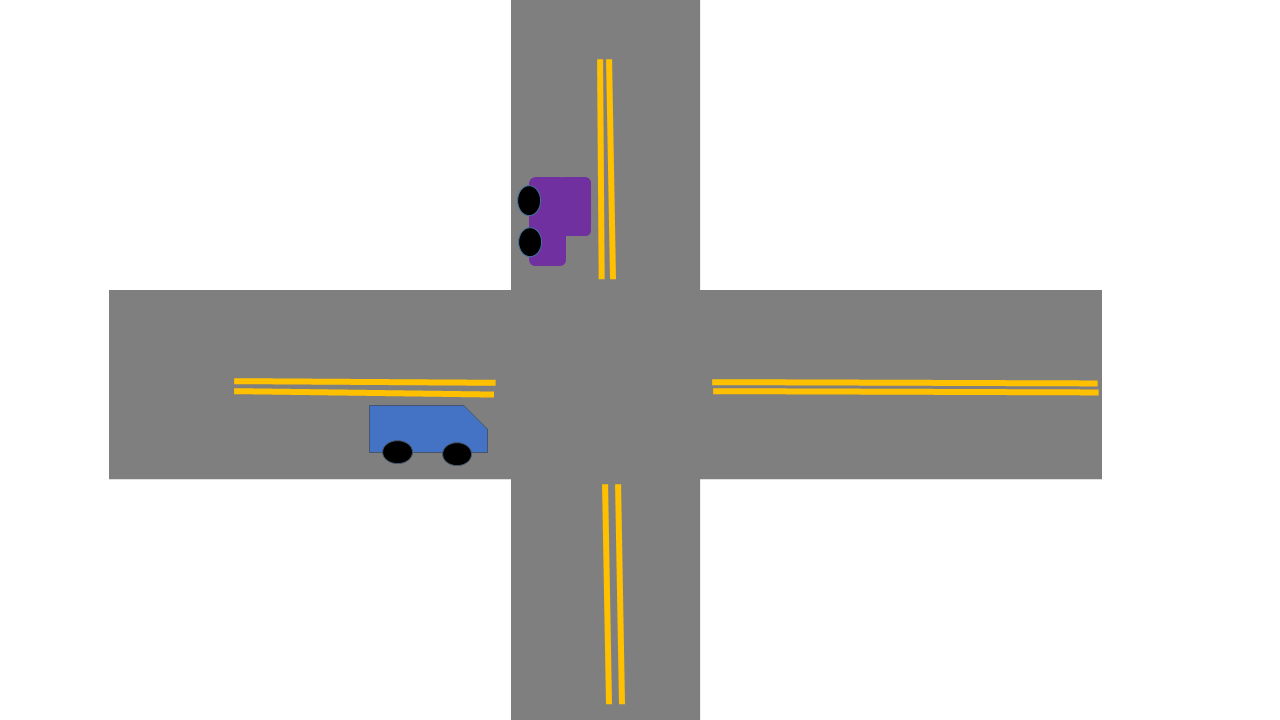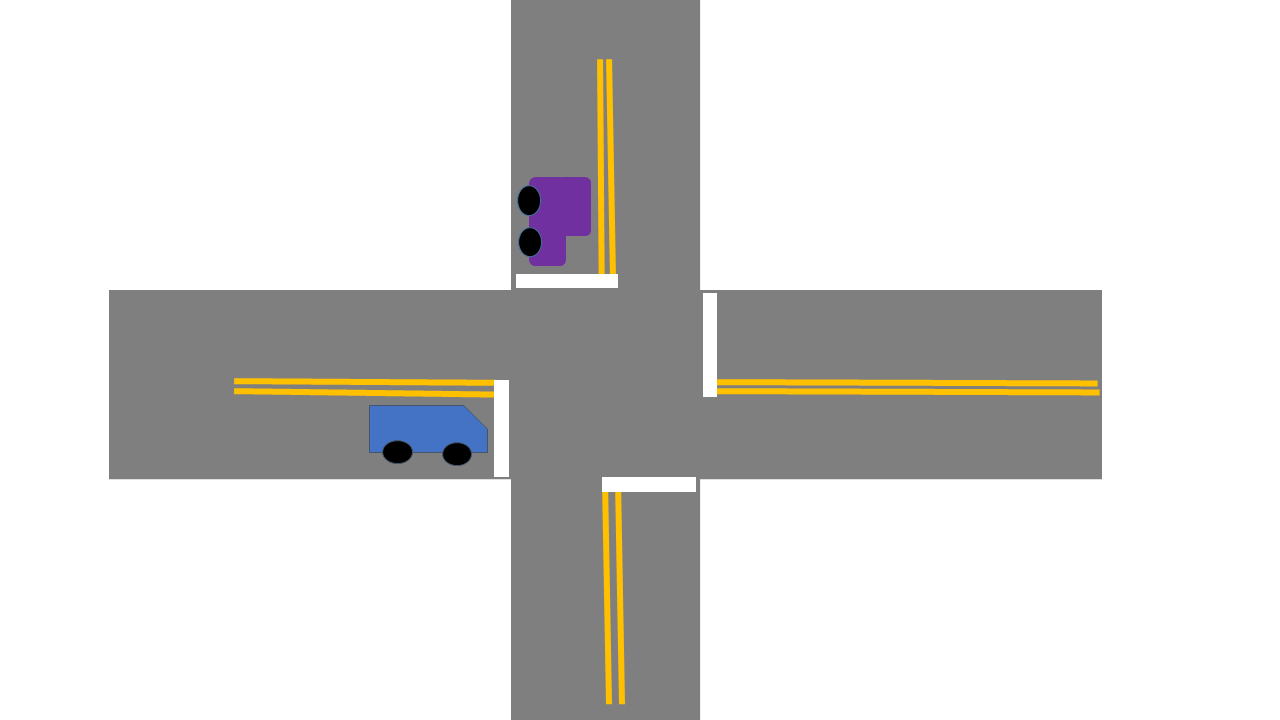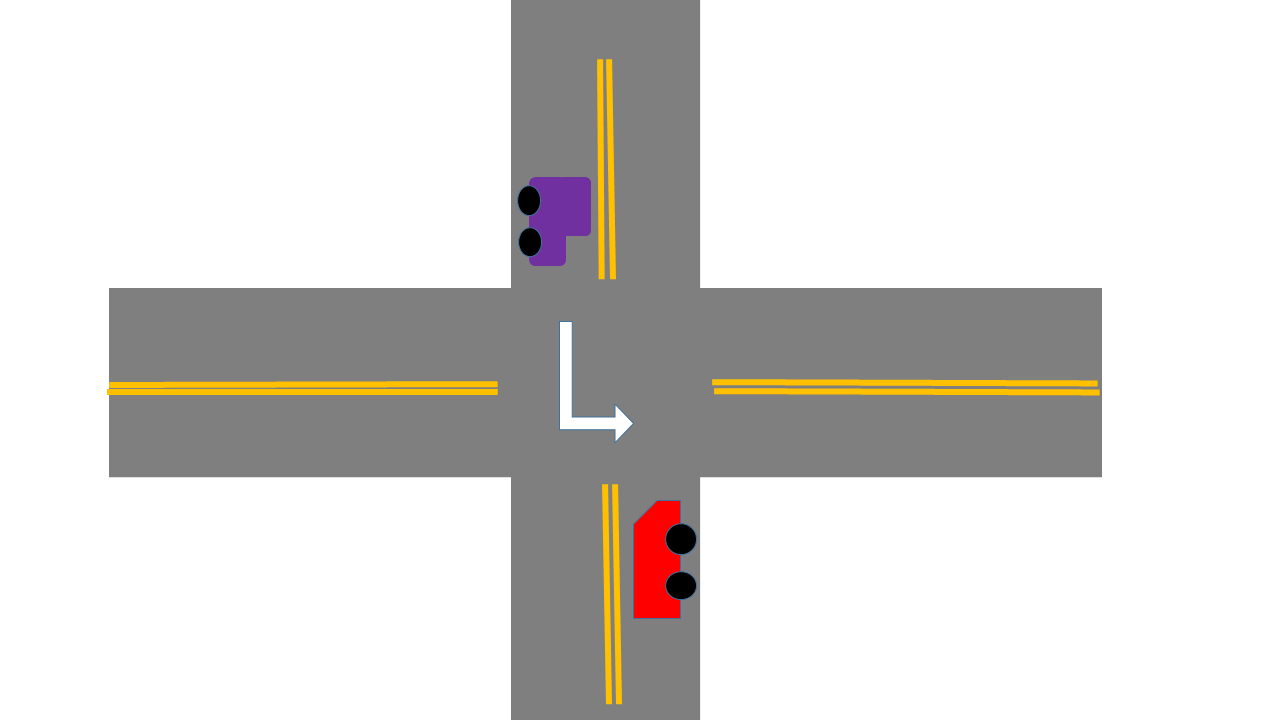Two vehicles, one traveling east and the other traveling south, arrive at approximately the same time at an intersection that is not marked by traffic signs or lights. Which vehicle may enter the intersection first?
The driver of the vehicle on the left must yield the right of way to the vehicle on the right. G.S. 20-155(a). Thus, at the intersection depicted in the image below, the purple vehicle must yield the right of way to the blue vehicle.

Two vehicles approach or enter an intersection at approximately the same time, within the meaning of G.S. 20-155(a), when considering their distances from the intersection, their speeds and other circumstances, the driver of the vehicle on the left should reasonably apprehend danger of collision unless he waits until the vehicle on the right has passed. Dawson v. Jennette, 278 N.C. 438, 445 (1971). The right of way is not determined by a fraction of a second. Id.
What if the intersection is marked by a four-way stop, as depicted this next image?

If both vehicles arrive at the intersection at the same time, the rule noted earlier still applies. The purple vehicle on the left must yield the right of way to the blue vehicle on the right.
What if, at an intersection without traffic lights, two vehicles approach at approximately the same time from opposite directions? The rule in G.S. 20-155(a) does not apply to vehicles proceeding in opposite directions that meet at an intersection. Fleming v. Drye, 253 N.C. 545, 549 (1960). Either vehicle may proceed straight ahead or turn right. But what if, as in the image depicted below, the driver of the purple vehicle has signaled her intention to turn left? Who has the right of way?

In this circumstance, the driver of the purple vehicle must yield the right of way to the driver of the red car so long as that car is proceeding straight through the intersection or making a right turn. G.S. 20-155(b).
Now assume that the intersection requires a four-way stop. The purple car intending to turn left arrives at the intersection before the red car. Whether the purple car is required to yield the right of way depends upon whether it has already entered the intersection before the red car arrives at the stop sign. If it has, then the purple car has the right of way. That’s because the approaching vehicle must be within the intersection or so close as to constitute an immediate hazard for the rule in G.S. 20-155(b) requiring the driver of a vehicle intending to turn left to yield to apply.
Next consider what happens when a vehicle approaches a traffic circle. A vehicle to the driver’s left is already in the traffic circle. Which vehicle must yield? The vehicle approaching the traffic circle must yield to the vehicle within the traffic circle. G.S. 20-155(d). As the DMV describes in its North Carolina Driver’s Handbook, “an entire traffic circle is an intersection.”
Thus, at the traffic circle depicted in the image below, the blue vehicle must yield the right of way to the red vehicle that is already in the traffic circle.

A driver’s failure to yield the right of way is an infraction punishable by a fine of not more than $100. G.S. 20-176(a), (b).
What if the intersection has a stop and go signal (stop lights) and a hurricane has knocked out the power? Two vehicles approach, 1 from the south and 1 from the east and they arrive at the intersection at the same time. Who goes first?
This is a common problem, as seen with recent hurricane Matthew, that frustrates drivers who then call police to direct traffic…which frustrates police because the drivers do not know the law.
Answer: 20-158 b6. When a traffic signal is not illuminated due to a power outage or other malfunction, vehicles shall approach the intersection and proceed through the intersection as though such intersection is controlled by a stop sign on all approaches to the intersection.
Excellent article. I would appreciate it if you would extend the article to include on-ramp merging traffic for both interstates and for local roadways including any differences as to who has the right of way for each. I’m given to understand that in interstates that the person merging must yield the right of way to existing traffic on the interstate but it appears that other on-ramp merges onto a non-interstate road falls under local law that seem to indicate that the person merging has the right of way and the existing traffic must adjust by slowing or changing lanes to facilitate the merge at this intersection of two roadways. Your thought?
This is useful. Thanks for posting. What about U turns? When are they legal and who must yield?
If vehicle A is traveling east and approaches a stop sign at an intersection and Vehicle B is traveling north but is 100 to 150 feet from the intersection, can vehicle A proceed without being in violation of yielding the right of way? The intersection is only one lane wide, vehicle A only needs to travel 25 feet to clear the intersection.
If you are traveling on a one way street and the traffic light is not working who has the right away?
it is always the person to the right